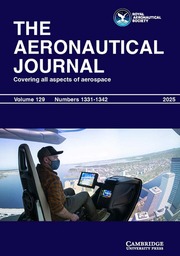Article contents
Modelling a helicopter rotor’s response towake encounters
Published online by Cambridge University Press: 03 February 2016
Abstract
In recent years, various strategies for the concurrentoperation of fixed-and rotary-wing aircraft havebeen proposed as a means of increasing airportcapacity. Some of these strategies will increase thelikelihood of encounters with the wakes of aircraftoperating nearby. Several studies now exist wherenumerical simulations have been used to assess theimpact of encounters with the wakes of largetransport aircraft on the safety of helicopteroperations under such conditions. This papercontrasts the predictions of several commonly-usednumerical simulation techniques when each is used tomodel the dynamics of a helicopter rotor during thesame idealised wake encounter. In most previousstudies the mutually-induced distortion of the wakesof the rotor and the interacting aircraft has beenneglected, yielding the so-called ‘frozen vortex’assumption. This assumption is shown to be validonly when the helicopter encounters the aircraftwake at high forward speed. At the low forwardspeeds most relevant to near-airfield operations,however, injudicious use of the frozen vortexassumption may lead to significant errors inpredicting the severity of a helicopter’s responseto a wake encounter.
Information
- Type
- Research Article
- Information
- Copyright
- Copyright © Royal Aeronautical Society 2004
References
- 9
- Cited by

